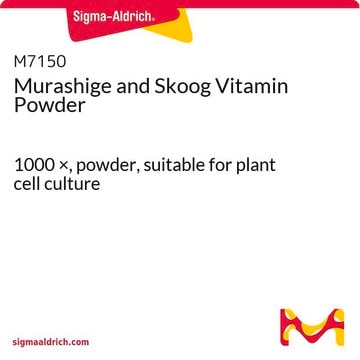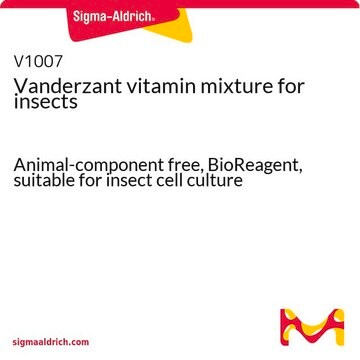S3766
Schenk and Hildebrandt Vitamin
100 ×, liquid, suitable for plant cell culture
Sign Into View Organizational & Contract Pricing
All Photos(1)
About This Item
UNSPSC Code:
12352207
NACRES:
NA.72
Recommended Products
form
liquid
Quality Level
mol wt
Mw 180.16 g/mol
concentration
100 ×
technique(s)
cell culture | plant: suitable
color
white
pH
3.25-4.75
application(s)
agriculture
Storage temp.
2-8°C
application
Schenk and Hildebrandt Vitamin 100 × (S3766) and Schenk and Hildebrandt Basal Salt Mixture (S6765) are chemstocks that may be used to generate Schenk and Hildebrandt (SH) medium for use in plant cell culture and microproagation.
Quantity
Package prepares 1 L of a 100× solution.
Reconstitution
Use at a concentration of 10 mL per 1 L of prepared medium to achieve the proper final concentration.
Storage Class
11 - Combustible Solids
wgk_germany
WGK 3
flash_point_f
Not applicable
flash_point_c
Not applicable
ppe
Eyeshields, Gloves
Certificates of Analysis (COA)
Search for Certificates of Analysis (COA) by entering the products Lot/Batch Number. Lot and Batch Numbers can be found on a product’s label following the words ‘Lot’ or ‘Batch’.
Already Own This Product?
Find documentation for the products that you have recently purchased in the Document Library.
Customers Also Viewed
Monya M Costa et al.
Biotechnology letters, 30(7), 1265-1270 (2008-02-15)
Six-year-old Levisticum officinale (lovage) hairy root cultures were used to study the effect of eight different NH(4) (+):NO(3) (-) ratios on their growth and volatile components. All cultures were kept at 24 degrees C on orbital shakers at 80 rpm
Suk Weon Kim et al.
Methods in molecular biology (Clifton, N.J.), 547, 107-115 (2009-06-13)
This chapter describes culture conditions for high-frequency plant regeneration via somatic embryogenesis and cryopreservation from cell suspension cultures of Ranunculus kazusensis. Zygotic embryos form white nodular structures and pale-yellow calli at a frequency of 84.9% on half-strength Schenk and Hildebrandt
Sung Jin Hwang
Methods in molecular biology (Clifton, N.J.), 547, 263-273 (2009-06-13)
Hairy root clones of Rehmannia glutinosa were established via transformation with Agrobacterium rhizogenes ATCC15834. To optimize the culturing conditions for both root growth and catalpol production, the effects of various combinations of seven basal media, pH, and carbon sources were
Inês S Nunes et al.
Planta medica, 75(4), 387-391 (2009-01-22)
The biotransformation capacity of Levisticum officinale W.D.J. Koch hairy root cultures was studied by evaluating the effect of the addition of 25 mg/L menthol or geraniol on morphology, growth, and volatiles production. L. officinale hairy root cultures were maintained for
Our team of scientists has experience in all areas of research including Life Science, Material Science, Chemical Synthesis, Chromatography, Analytical and many others.
Contact Technical Service







